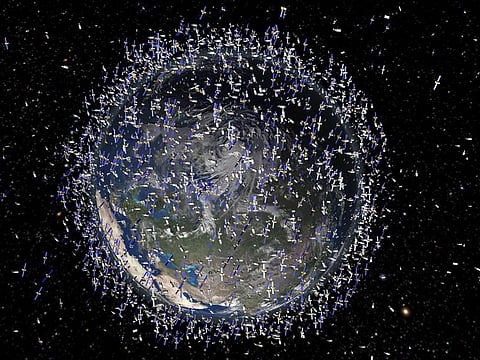100,000 satellites: A sky full of spacecraft? The race to blanket Earth from space
Is the future of the internet above us, in a mantle of satellites, or on down here below?

Look up on a clear night, and you might see something unexpected: not stars, but satellites — gliding in neat lines across the sky.
As they orbit the Earth, satellites have many proven uses: for the government, the military and civilians.
Cost-effective internet, broadband or high-definition TV, GPS are impossible without satellites.
They offer so much more.
Space race is on
A quiet space race is unfolding above us as tech giants and governments rush to wrap the Earth in a digital blanket of satellites, promising global internet access and real-time data at unprecedented scale.
At the forefront is Elon Musk’s Starlink, a project by SpaceX aiming to launch as many as 42,000 satellites into low Earth orbit (LEO), defined as the altitude between 160km and 2,000km.
Already, 7,135 Starlink satellites are circling the planet (7,105 of them actively working, as of May 9, per astronomer Jonathan McDowell, beaming internet signals to users in remote areas — from rural Alaska to disaster zones in Ukraine.
Musk envisions a fully connected world, one where broadband flows as freely as air.
But Starlink is no longer alone in the skies.
Amazon’s Project Kuiper is preparing to send up more than 3,200 satellites, with two prototypes already orbiting Earth and mass deployment expected by 2026.
Backed by Amazon’s cloud empire, Kuiper hopes to tap into underserved markets and compete directly with Starlink for global broadband dominance.
Europe
Europe is also stepping into orbit.
The European Union’s IRIS² (Infrastructure for Resilience, Interconnectivity, and Security by Satellite) aims to provide secure communications for EU governments and offer connectivity for European citizens, especially in areas where terrestrial internet is unreliable or nonexistent.
It's Europe’s answer to tech dependence on American firms — and a major stride toward digital sovereignty.
China
Meanwhile, China is racing to deploy its own megaconstellation of nearly 13,000 satellites under a state-led initiative known as Guowang.
Like its Western counterparts, China’s vision includes nationwide coverage, military applications, and a foothold in the booming space economy.
Beijing has been investing heavily in commercial space ventures and rocket launches to speed up deployment.
Orbital 'clutter'
Critics warn that this satellite surge could clutter Earth’s orbit with space debris and intensify risks of collisions — potentially triggering a cascade of orbital junk that threatens both satellites and space missions.
Astronomers also raise alarms about “sky pollution,” as satellite glare interferes with ground-based observations of the universe.
Still, the momentum is undeniable.
Why international cooperation is needed
Projections suggest that by 2030, the number of satellites in orbit could reach 100,000.
To manage this, there's a need to developi space traffic management systems to handle the increased congestion and ensure sustainable use of LEO, as per Aviation Week.
However, the current regulatory framework is fragmented.
This is why international cooperation is essential to establish comprehensive guidelines for satellite deployment, operation, and deorbiting to mitigate collision risks and maintain the long-term viability of space activities.
Advantages of LEO
The proximity of LEO satellites to the Earth allows for various benefits, including:
High-resolution imagery: Satellites in LEO can capture detailed images of the Earth's surface.
Easier access for transportation and resupply: The shorter distance to the Earth makes it easier and faster to transport materials and astronauts to and from LEO satellites.
Orbital period: Satellites in LEO have relatively short orbital periods, typically ranging from 90 minutes to 2 hours.
Examples: The International Space Station (ISS) operates in LEO, as do many weather satellites and Earth mapping satellites.
Lower latency: This it the biggest LEO advantage, due to their proximity to Earth. This enables faster data transfer and real-time communication, and the ability to provide broadband access to remote or hard-to-reach areas. LEOs can also provide global coverage and offer a more flexible and cost-effective solution compared to higher-orbit satellites. [Source: ScienceDirect]
100,000 satellites?
While LEO can accommodate a large number of satellites, reaching figures like 100,000 would require significant advancements in space traffic management.
It would also require international protocols and regulations, as well as debris-mitigation strategies to ensure the safety and sustainability of orbital operations.
So it turns out, Internet is no longer bound by wires or towers — it’s increasingly coming from space, fast and everywhere.
Whether it’s for streaming, surveillance, or reaching the next billion users, the sky is getting crowded, and the race to own it is just beginning.
In this high-stakes orbital rush, one thing is certain: the future of the internet is above us.
Sign up for the Daily Briefing
Get the latest news and updates straight to your inbox



